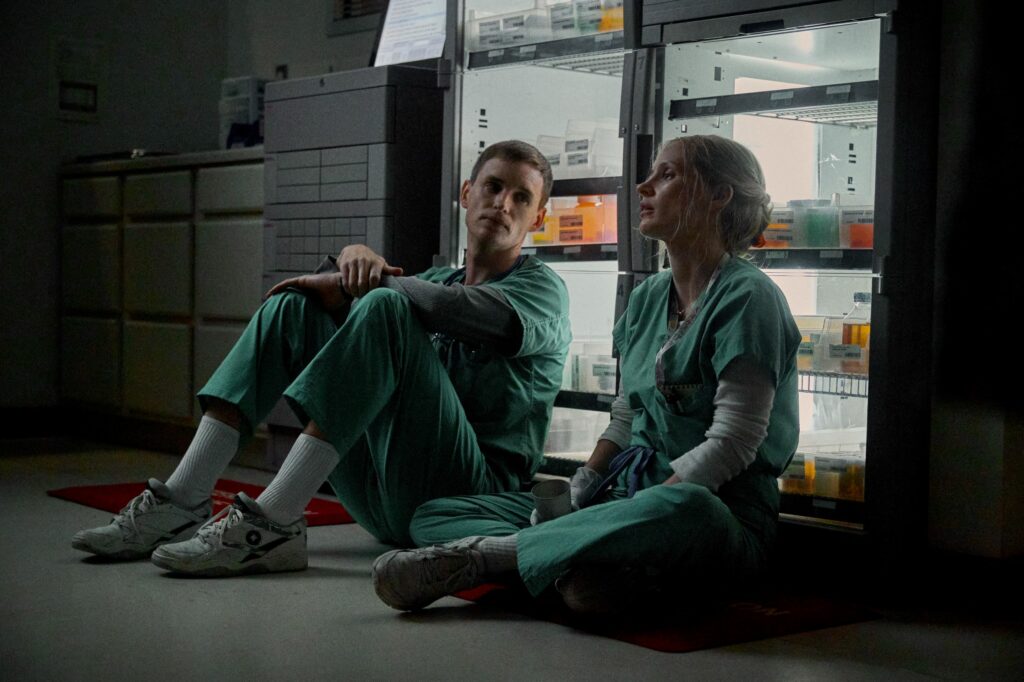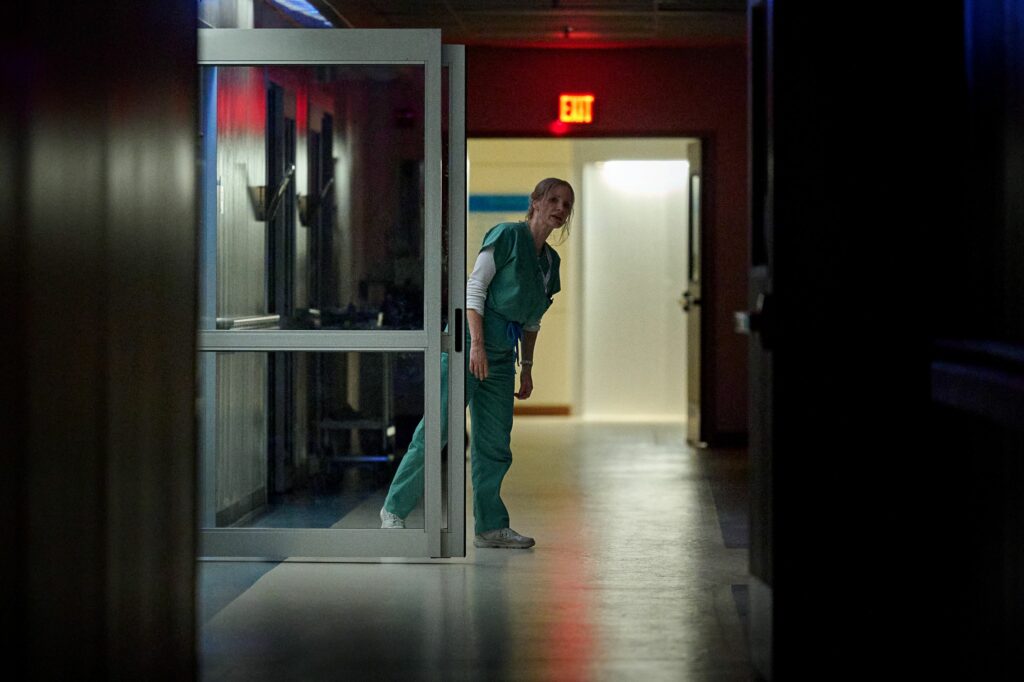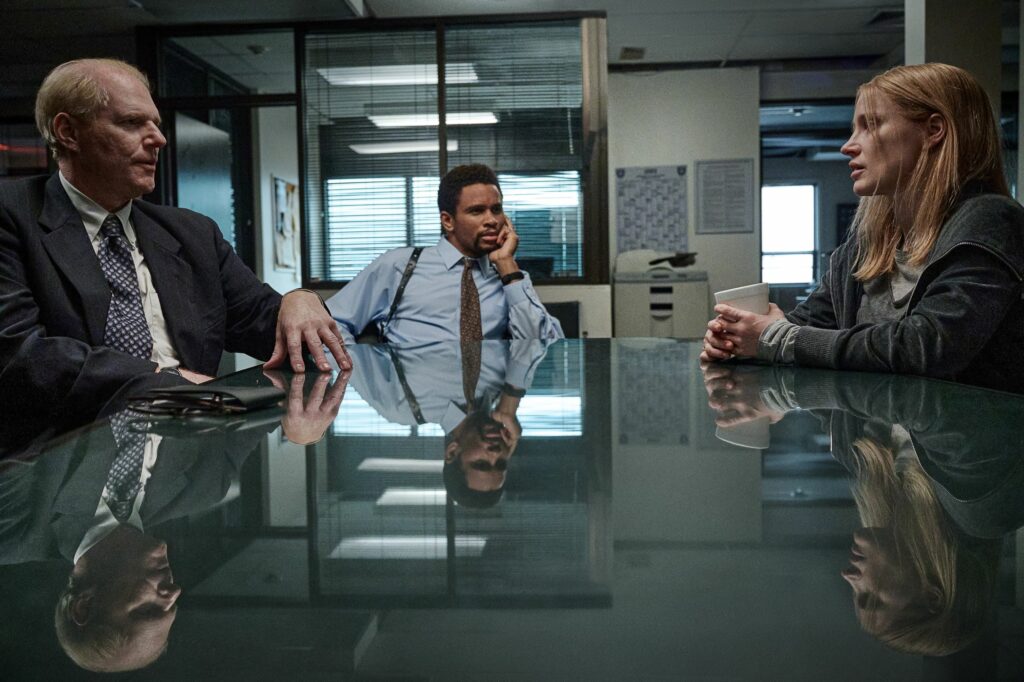The Good Nurse follows Amy Loughren (Jessica Chastain), a nurse and single mother with a life-threatening heart condition, who is stretched to her limits by demanding night shifts at the ICU. Thankfully, help arrives when Charlie Cullen (Eddie Redmayne), a thoughtful fellow nurse, transfers to her unit. The two soon develop a strong and supportive friendship. But after a series of mysterious patient deaths sets off an investigation that places Charlie as the prime suspect, Amy is made to risk her safety to uncover the truth – that Charlie is responsible for the murder of dozens of patients over a period of sixteen years, across two states and nine hospitals, without ever being charged.
Directed by Tobias Lindholm (Another Round) from a script by Krysty Wilson-Cairns (1917, Last Night In Soho), The Good Nurse is based on the 2013 investigative book by Charles Graeber and recounts the events that led to Cullen’s capture from the perspective of the woman who considered him a close friend and would help the police to stop him. Ahead of the film’s release, Outtake spoke with Lindholm about controversies surround the True Crime genre and what we have to learn from Amy Loughren’s story.

This being your first English-language feature, what attracted you to the project?
Tobias Lindholm: For years, I’ve been looking for that story that could be the bridge from Denmark to the English-speaking world. Reading Krysty’s first draft made me realise that this was not just another serial killer movie, it was much more a portrait of a real-life superhero. Amy is a struggling, lonely mum – much like my mom – who stood up against the system, and did what the system couldn’t do, which was to stop the most prolific serial killer in American history. So that got me on board right away. Krysty’s script was already on the right path, so all we did together was refine that and make sure we got rid of all the cliched serial killer movie scenes and just find the truth in them.
The true crime drama genre has been the subject of heated debate for a while now, and the conversation has ramped up with the release of the Dahmer series on Netflix. With The Good Nurse, how did you create a sense of threat and high stakes without exploiting the real-life subjects at the story’s heart?
Tobias Lindholm: As storytellers, when dealing with true life events – not just true crime, but true stories in general – we have a huge responsibility to the people in question. And in this case especially, because we’re retelling someone’s biggest nightmare. And to make cheap thrills of that would, for me, be inhumane.
And Amy’s superpower is humanity. So, the only way to tell her story was to do it with humanity. On top of that, I don’t think that Charlie Cullen is the fascinating part. The fascinating part is that Amy was able to stop him and that the system wasn’t. The fact that he was allowed to continue to do this meant that he wasn’t a genius serial killer that we could be fascinated with – that’s all Amy.
But I agree that we have a huge responsibility; I think that it’s about time we have that conversation about true crime. True crime is not even a genre, it’s this big darkness that we just all stare into. And then we get entertained by these nightmares – and I get why. Life is hope and fear, and true crime definitely represents fear. But I actually think The Good Nurse represents hope.

Part of the reason why Charles Cullen isn’t this exaggerated, fascinating figure is that you don’t try to speculate on his motivations. Could you talk about that decision?
Tobias Lindholm: I get the question is there because we have a need to bring order into chaos, but I don’t think that the answer is there. Would we have trusted Charlie Cullen if he explained why? Of course not. It would just be him trying to tell a version of the story that portrays him in the way he wants to be portrayed. I found it much more interesting to ask another question, which was: why and how did we allow this to happen? Because that’s what we can change.
I see why we could try to analyse what went wrong in his childhood or something like that, but I don’t think there’s an answer. There’s no recipe on how to become Charlie Cullen, so there’s nothing to learn from that. I think we have to accept that once in a while, darkness is there. What we can learn from this is how to deal with it. And that’s what Amy’s story is a reminder of, that humanity matters and that you need to confront darkness to stop it. We have an individual responsibility within the systems we live in, to speak up when we see the inhumane.
It’s interesting that there’s never any doubt about who the real villain is – the institutions that knowingly allowed the murders to continue. And we get the sense that this oppression is felt in the way you frame the camera and make use of intense close-ups. Can you tell us more about the stylistic elements that went into building that tension?
Tobias Lindholm: From the first shot of the film, where we just slowly zoom in on Charlie as he stands there at the foot of the bed of a dying patient, watching his colleagues trying to save the patient, we wanted the frame to represent the system. That way, the individual is caught in the system. That’s why there are so many lines in all the images – we see doorframes, desks, or whatever else dividing the screen into different squares. The characters are caught in those squares and cannot move.
And in the first half of the film, when Amy doesn’t know that Charlie is the killer, the shots are broader and more searching. In the second half, she knows that he’s the killer, so the camera moves closer and instead of searching, we just observe. That became the methodical way that we built the tension.
I’m very inspired by the heroes from the 70s. I remember David Fincher, when I did Mindhunter with him, he showed me Klute (1971). I actually think Klute is my biggest inspiration for this film; in the diner scene when Amy is confronting Charlie for the first time, the reason we chose that diner was that the lamps there look exactly like the living room of Klute. So, go find it!

That’s a fun Easter egg. By that logic though, if the frame is the system and the individuals are trapped within the frame, do you view Charlie Cullen as a victim of the system?
Tobias Lindholm: No. And I don’t look at anybody as a victim of anything – the only victims here are the victims of Charlie Cullen’s crimes.
Perhaps victim is the wrong word. Would you consider him to be trapped?
Tobias Lindholm: I definitely see him as trapped. I think that Amy reminding him of his own humanity proves that. He lost his humanity, and she reminds him of it, and therefore he is stopped. I think that we are all slaves to the system if we’re not careful. And Amy was one of those that didn’t allow the system to beat her.
I feel it. I’m from Denmark, where we think we’ve figured it all out with our healthcare system and everything. But let’s be honest: we still have a lot of problems to deal with and we still have a lot of systemic oppression. And if we don’t confront that and remind ourselves of our basic humanity, then often we will end up not as victims, but as slaves of systems.
The Good Nurse releases in cinemas from October 19th, and will release to Netflix on October 26th.
